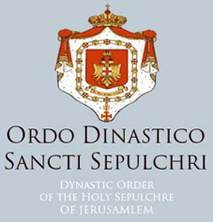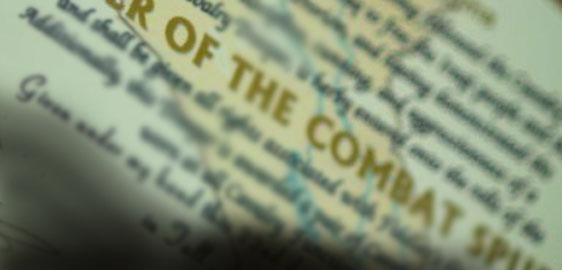


Section II:
THE Chivalry – Classification of the Orders
The historians of Chivalric Orders have diversely classified the institutions and the Equestrian Orders. The bibliography of the Orders and about their institutions of Chivalry is considerable. We limit ourselves at this stage to quote only a group of works particularly worthy of note, to serve our purpose.
The famous Sansovino F., in the middle of the XVI century, has formulated the first partitions: The Orders of the COLLAR, reserved to Sovereigns and High Personage, have no religious vows not even other rules except those of honour and of Chivalry, and generally “NAZIONAL” (example: SS. Annuziata, Toson d’Oro or GOLDEN FLEECE, those of the GARTER etc.);
The Order of the Cross, known also as Ecclesiastical Militants or Religions, they were subject to special rules, and lived in community life, they also professed vows, and had an international character (example: The Sacred Religion and Military Order of St. John of Jerusalem);
The Order of the SPURS, conferred by the Popes or the Kings to reward persons who performed good and exceptional deeds. This tripartition is still accepted now by some heraldists and some jurisprudence experts. Another division was developed by one of the most recognised professors of the XVIII century, his name P. Onorato di Santa Maria. He distinguishes the Hereditary and National from that which is acquired, which he divides in:
Roman
Military – for military fetes
Honorary – destined to reward civil and religious good deeds
Social
Ecclesiastic – Knighthood of honour
Regular – which has a religious rule
Female – which is considered only as an honorary reward.
Another famous author Maigne, in 1861, limiting his comments on the Honorary Knighthood has proposed to divide these in three types:
Great Orders – destined only to Reigning Monarchs and distinguished high-ranking persons.
Courtesan Orders – destined only for aristocracy.
Orders of Merit – accessible to all as Decorations as a “Thank You” reward for distinguished services.
The Critics have pointed out the defects of these and other classifications, which we prefer to omit for brevity. However, we would like to trace down a system of division of Orders under the jurisprudencial aspect and in this system we are going to consider only existing Orders and excluding those who had been extinct.
Note: cfr. Patetta F., Studi Storici e note sopra alcune iscrizioni medioevali, nelle “Mem. R. Accad. Scienze e Lettere” Modena 1909, Serie III, Vol. VII; Pivano C., “Lineamenti Storici e giuridici della Cavalleria medioevale, nella Mem. R. Acad. Sc.” Torino 1907, and the Treatese of C. Arnone, Classificazione degli Ordini Cavallereschi, nella
“Riv. Araldica” 1938 fasc. IX, p.p. 404 –414.
STATE ORDERS:
Those which appear as a moral person or juridical public person: e.g. "The Legion of Honour” considered as a model of Chivalric Orders, in the democratic state, which existed after the French Revolution.
DYNASTIC STATE ORDERS:
Structural: Those, which before the French Revolution belonged to the Heraldic Patrimony of the Crown. In Italy these would included the Orders of the Annunziata and that of Saint Maurizio and Saint Lazarus.
DYNASTIC STATE ORDERS:
These Orders are considered Dynastic because it is an accepted juridical tenet, and also under International Law de facto, a dethroned Prince, although he loses his throne, he will still hold his Jus Collazionis of his Dynastic Orders. Therefore even in the present time there exist pure Dynastic Orders, which are not attached to the sovereignty of the State.
There is the case of the Constantinian Order of St. George, whose De Jure Legittimacy is out of any discussion. Another Order considered as the one aove, is the Order of the Holy Sepulcre (previously known as Orthodox Order of the Holy Sepulchre). Order of the Holy Sepulcrfe belongs exclusively to the Rurick Dynasty, through the marriage in A.D. 1472 between Zoe (Sofia) Paleologina niece of the Emperor of Byzantium Constantine XI Paleologo, and Ivan III Vericky (the Great), Grand Duke of Russia. This marriage brought to Ivan and his descendants, the Title of Pretender to the Throne of Byzantium, and encourages the absorption of many noble Houses and Chivalric Orders founded during the Byzantine Empire. Hence, the title of “Zar” which means “Caesare”. We will expand on Dynastic Orders later in a different section.
PONTIFICAL ORDERS:
The Church directly or indirectly controls these Orders, and are to be considered as emanating from the spiritual sovereignty of the Church, which Sovereignty is to be considered gerarchically superior, in theory, to that of the State.
Some jurists seem to prefer to put the Jus Honorum of the Holy See on the temporal sovereignty rather than on that which is spiritual. But when Rome – that is the Holy See – lost its temporal status from 1870 to 1929, it would have lost the right to confer honours, which is contrary to the de facto truth.
The majority of these Orders are not derived from the old monastic Orders of the Church and therefore, they mostly practice the secular or laical character of the State orders. In fact they have a laical crisma, in as much that they cannot be conferred to ecclesiastics, whether secular or regular (with the exception of the Order of the Holy Sepulchre), and in as much as vice versa they can be conferred even in exceptional cases to non Christians.
MAGISTRAL ORDERS:
By right, we can only put the Order of St. John of Jerusalem, of Rhodes and of Malta, which is commonly known as the Sovereign Military Order of Malta (S.M.O.M.), in this category. The juridical position is most special, because this Order contains two distinct prerogatives: The Religion (Monkshood) and the Chivalric Order annexed to the religion, hence, “Religio Militaris” military Order of monks.
The Sovereignty, in the form of a person of international law, is an attribute of the Religion; this is understood under the technical Juridical Canon Law Subject. The Grand Master, Head of the Religion (monks), the Supreme Head of the Order, appears to be the holder of the sovereignty. In fact in some cases he was referred to as the “Sovereign” for as much as he appeared as Temporal Prince like all the others of that time and eras.
Therefore, since this Order is dependent on the Grandmastership, it is opportune for the jurists to call this Chivalric Order “Magistral” and not of the State. Substantially, the Orders mentioned in these sections are all based upon the existence of a Sovereign state, a Sovereign Prince, a High Pontiff who is a spiritual and temporal sovereign, hence they are called a Sovereign Order. This is what is always undoubtedly accepted in the Juridical Law and Public Law.
No proper Orders can exist, therefore, outside these Orders” Categories. Those outside this category will be simply considered “Associations”; because the Jus Honorum (Fons Honorum, - Jus Honorandi) has a transcendental character and therefore it can only be emanated from a legitimate Sovereignty.
The Classification of these Orders, under the aspects of modern Public Law, jurisprudence, serves mostly to clarify the meaning of the terms that will be used as we proceed in this dissertation. Naturally, when the Chivalric Orders emanating from the Church, or those subject to It’s protection are discussed, there is fundamental distinction in value. On one side the Chivalry defined as military, regular or effective and on the other side that which is called Honoraria (Honorary).
The Military and Regular Orders
This category comprises the Orders that were formed during the times of the Crusades. These Military Orders which were founded by private initiatives and not by the Pope or Kings, defended the faith and many times carried out hospitalier functions.
These Rules, imposed especially upon the monastic Orders demanded a special way of life inside a convent or commanderie (like that of S.M.O.M.).
Very rarely, secular Knights were obliged to say special prayers and abstain. These Knights took the vows of poverty, chastity, and obedience, and always had the duty to assist the sick, the pilgrims and the poor, to protect the widows and orphans, and to take up arms for the defence of the Church. These Military or Religious Orders adopted different monastic Rules. The famous Santa Maria reveals that the following Orders were under the rule of Saint Basil:
The Order of the Lilly
The Order of Saint Catherine of Mount Sinai
The Order of St. Biagio
The Orthodox Order of the Holy Sepulchre (Later known as Order of the Holy Sepulchre)
The Order of the Holy Sepulchre instituted by Henry II King of England in 1174, and many others.
The rule of St. Augustine of Hyppo was followed by: the Knights of Saint Lazarus; the knights of St. John of Jerusalem of Rhodes and of Malta; the knights of the Holy Spirit of Rome; the Teutonic Knights; those of St. John of the Sword (both Portuguese and the Spanish) and those of Saint dominic or Militia of Christ.
The Rule of St. Benedict was followed by the Knights of the “Avis”, of “Calatrava”, of “Alcantara”, of “Livonia” and others.
The Carmelite Rule was followed only by the Order of Our Lady of Mount Carmel (see Santa Maria [OA]). “Disserzione Storiche, Critiche, sopra la cavalleria antica e moderne, secolare e regolare”. Bascape’ – 1761: Translation from the original that was published in Paris in 1718.From the Middle Ages and the early years of the modern ages the so called “Branche Militri” (military offshoots) of some of the Military Orders also belonged to this category. For examaple the Mercedri – who in the scond period as soon as their military functions ceased, became “Honorary” and they are classified as Knighthood of honour.
Those who wanted to be accepted in the Military Orders had to serve for a period of time as Novices. Then they were allowed to have an investiture, which took place under a severe and slemn ceremony, in church and in the presence of a Bishop or the Grand Master, or an Abbot or at least a Prelate. After taking the vows and completed other formalities the knight was given the sword, the military cordon, the golden spurs.
A typical example of the Military Orders or Military Regular Orders is the Order of St. John of Jerusalem, called also of Rhodes and of Malta, whose effective members to this day are obliged to profess Religious Vows same as those taken by monks.
Read More...
The Honorary Knighthoods of the Church
